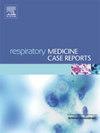Acute fibrinous and organizing pneumonia after lung transplantation: A case report of treatment with infliximab and tocilizumab and literature review
IF 0.8
Q4 RESPIRATORY SYSTEM
引用次数: 0
Abstract
Introduction
Acute fibrinous and organizing pneumonia (AFOP) is a severe form of acute lung injury which can occur after lung transplantation. Treatment is empiric, based on immunosuppressive regimens and the mortality rate is very high.
Case presentation
We report the case of a young lung transplant (LT) recipient who developed AFOP following a respiratory viral infection while on suboptimal maintenance immunosuppression due to adherence issues. Diagnosis was confirmed by cryobiopsies showing intra-alveolar fibrin balls. Despite high dose systemic corticosteroids, the patient developed severe respiratory failure requiring mechanical ventilation. IV infliximab and tocilizumab were administered. The patient was extubated 11 days later and discharged to home 42 days after intubation with 1L/min O2. She developed severe pleuritic pain needing opioid treatment and died 4 months later.
Conclusion
While high-dose systemic corticosteroids remain the first line of treatment, the use of anti TNF-α has shown promising results in case reports. Furthermore, we propose prompt realization of a cytokine panel analysis in both blood and bronchoalveolar lavage to better guide the adjuvant administration of a targeted anti-inflammatory therapy.
肺移植术后急性纤维性和组织性肺炎:英夫利昔单抗与托珠单抗联合治疗1例并文献复习。
简介:急性纤维性和组织性肺炎(AFOP)是肺移植后发生的一种严重的急性肺损伤。治疗是经验性的,基于免疫抑制方案,死亡率非常高。病例介绍:我们报告了一例年轻的肺移植(LT)受者,他在呼吸道病毒感染后发展为AFOP,同时由于依从性问题而进行了次优维持免疫抑制。低温活检显示肺泡内纤维蛋白球证实诊断。尽管使用了大剂量全身皮质类固醇,患者仍出现严重呼吸衰竭,需要机械通气。给予静脉注射英夫利昔单抗和托珠单抗。11天后拔管,42天后以1L/min O2出院。她出现了严重的胸膜痛,需要阿片类药物治疗,4个月后死亡。结论:虽然大剂量全身皮质类固醇仍然是一线治疗,但在病例报告中使用抗TNF-α已显示出令人鼓舞的结果。此外,我们建议尽快实现血液和支气管肺泡灌洗中的细胞因子面板分析,以更好地指导靶向抗炎治疗的辅助管理。
本文章由计算机程序翻译,如有差异,请以英文原文为准。
求助全文
约1分钟内获得全文
求助全文
来源期刊

Respiratory Medicine Case Reports
RESPIRATORY SYSTEM-
CiteScore
2.10
自引率
0.00%
发文量
213
审稿时长
87 days
 求助内容:
求助内容: 应助结果提醒方式:
应助结果提醒方式:


